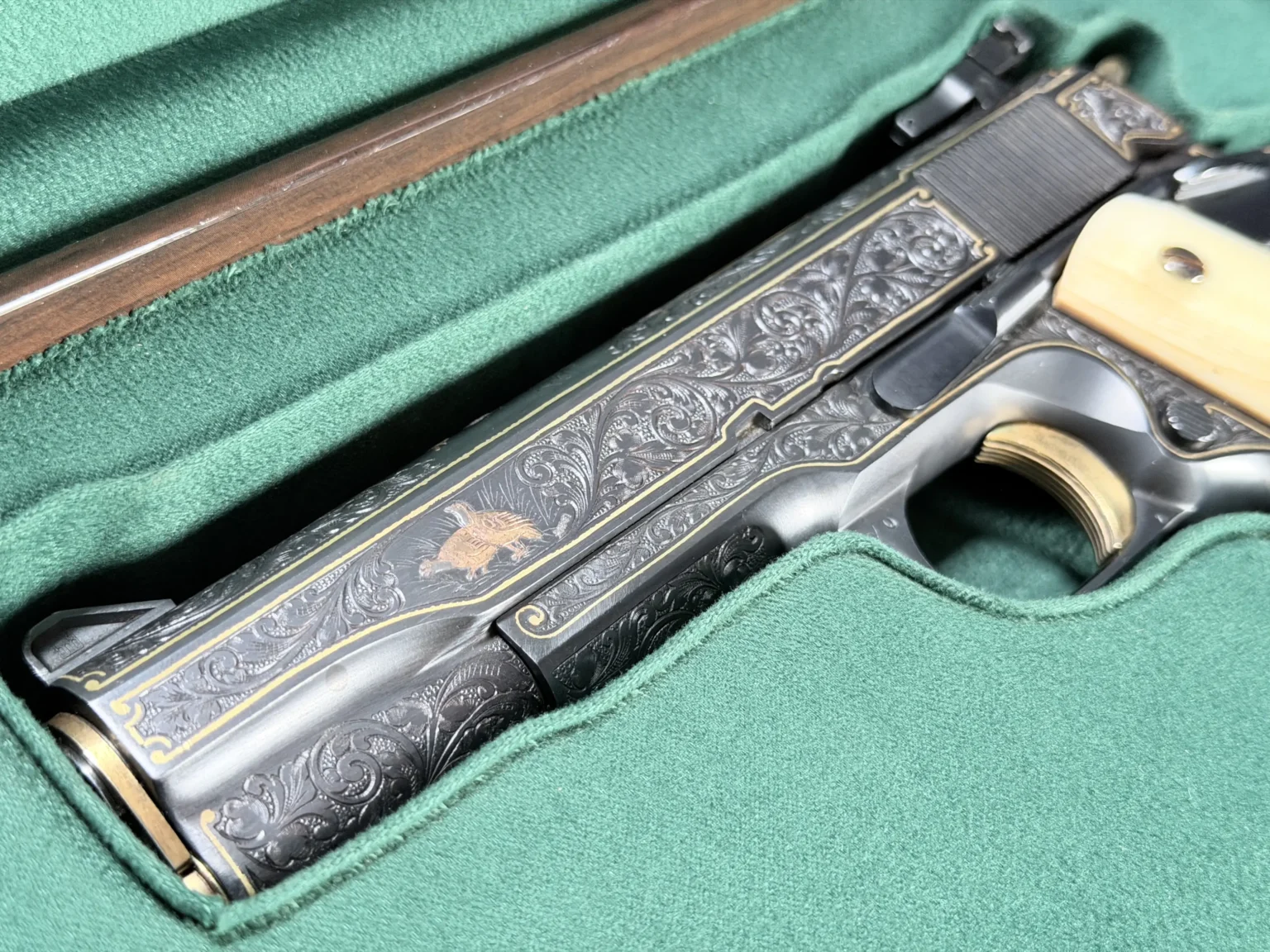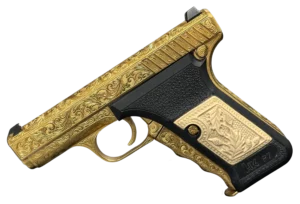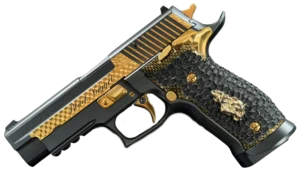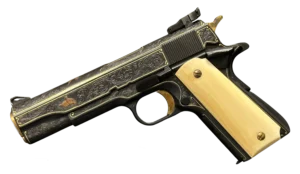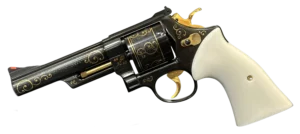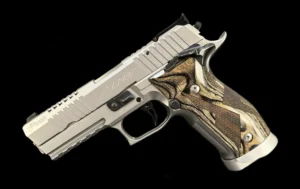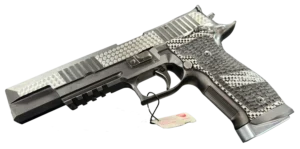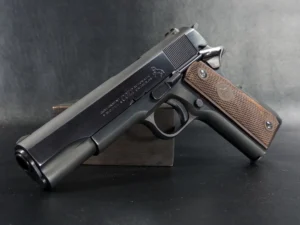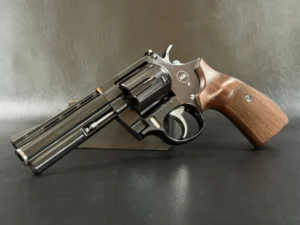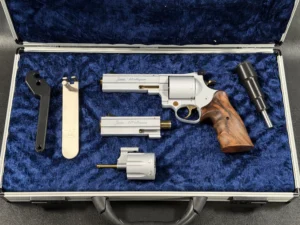Key Takeaways:
- Master engravers can turn a regular firearm worth maybe five grand into something that sells for fifty thousand or more. Not because the gun shoots better, but because someone spent months turning it into a microscopic art gallery. Guys like Gustave Young and L.D. Nimschke is basically the Picasso of the gun world, and collectors lose their minds over their work.
- This isn’t some dying craft either. There’s still this whole apprenticeship system where young engravers learn from old masters who learned from even older masters, creating this unbroken chain of knowledge going back centuries. And honestly, even with all our modern tech and laser engraving machines, collectors can still tell the difference between hand-engraved work and machine stuff. The human touch looks different.
- If you’re thinking about this from an investment angle, engraved firearms are weirdly stable. They exist in this strange little bubble where art collectors and gun collectors overlap, so even when the regular gun market tanks, the really well-engraved pieces hold their value or even increase in value. Just don’t try to “restore” one if you get your hands on it. Collectors want that original condition, patina, and all.
You know what’s wild? A gun can go from being worth a few thousand bucks to suddenly commanding six figures at auction. The difference? Some guy with steady hands and a tiny chisel spent months carving patterns into the metal.
That’s the thing about firearm engraving. It’s this weird intersection where deadly weapons become art galleries. And honestly, once you start looking at what master engravers can do, you can’t unsee it. Every gun starts looking either breathtaking or boring.
The Whole Engraving Thing, Explained
So here’s what engraving actually is: someone takes a sharp tool and literally cuts designs into metal. That’s it. Sounds simple, right? Except it’s absolutely not. We’re talking about creating microscopic grooves that somehow add up to eagles, scrollwork, hunting scenes, whatever. And they’re doing this on curved surfaces, around corners, into tiny spaces where your pinky finger wouldn’t even fit.
The crazy part is that this has been going on for centuries. Back in the Renaissance, rich guys started wanting their guns to look as fancy as their swords. Can’t blame them, really. If you’re going to carry something that announces “I have money and I might shoot you,” might as well make it pretty.
What started as simple decorative lines turned into this whole art form. By the 1800s, engravers were creating these insanely detailed scenes. Picture this: a Colt revolver with an entire Civil War battle carved onto the cylinder. Each soldier is smaller than a grain of rice. And somehow, you can still make out their uniforms.
The techniques kept getting better, too. First, it was all hand tools. Then someone figured out pneumatic engravers, which are basically tiny jackhammers for metal. Sounds easier, right? Not really. It’s like saying a Ferrari is easier to drive than a horse. Sure, technically. But you still need to know what you’re doing or you’ll crash into a tree.
Who Are These People?
Master engravers are a different breed. Most of them spend literally decades learning this stuff. And I mean decades. You don’t just pick up an engraving tool and start making masterpieces. You begin by making garbage. Then slightly better garbage. Then, after years, maybe something that doesn’t embarrass you.
The apprenticeship system is still huge in this world. Young engravers learn from old masters who learned from even older masters. It’s like this unbroken chain going back centuries. The guy teaching you might be using techniques his teacher’s teacher’s teacher invented in the 1800s.
Think about that for a second.
These aren’t just craftsmen, they’re artists who happen to work on guns. They pull inspiration from everywhere: nature, mythology, and personal stories. I’ve seen a Browning shotgun with the entire story of Icarus engraved on it. Another one had a forest scene so detailed you could identify individual tree species. On metal. With a chisel.
The prestige these guys have in the gun world is something else. When a known master engraver touches a firearm, its value goes through the roof. We’re talking about names that collectors whisper like they’re discussing Picasso. Gustave Young, L.D. Nimschke, these guys are legends.
The Money Side (Because Let’s Be Real)
Here’s where things get interesting for collectors. A standard Winchester might be worth, say, five grand. Get someone like Angelo Bee to engrave it? Now we’re talking thirty, forty, maybe fifty thousand. For the same gun. Just prettier.
And it’s not just about the money, though that’s obviously huge. Custom engraving turns a mass-produced firearm into something unique. You can get your family crest carved into it, your dog’s portrait. I’ve seen one with the entire text of the Second Amendment in microscopic lettering. Whatever floats your boat.
The personalization aspect is huge. Your grandfather’s initials on a hunting rifle suddenly make it an heirloom instead of just a gun. A commemorative scene from a specific hunt turns it into a story you can hold. These aren’t just weapons anymore; they’re family artifacts that happen to shoot.
From an investment angle, engraved firearms are weirdly stable. Even when the gun market dips, the really well-engraved pieces hold their value. Sometimes they even go up. It’s like they exist in their own little economic bubble where art collectors and gun collectors overlap.
The Big Names You Should Know
Colt’s Master Engravers
Colt revolvers are already iconic. The gun that won the West and all that. But when someone like Gustave Young got hold of one? Different story entirely.
Young was obsessed with movement. His scrollwork looks like it’s flowing across the metal. Animals that seem ready to leap off the gun. Flowers that look like they’re swaying in a breeze. The guy could make steel look soft. His stuff from the early 1900s still makes modern engravers jealous.
Then there’s L.D. Nimschke. Totally different style. Where Young was all about organic flow, Nimschke was geometric precision. Sharp lines, perfect angles, patterns that hurt your brain if you stare too long. His work is immediately recognizable. You see a Nimschke piece, you know it.
The relationship between Colt and their engravers was special. They weren’t just hiring contractors; they were building this whole culture of artistry around their firearms. Smart move, honestly. Turned their guns from tools into status symbols.
Browning’s Artists
John Browning designed some of the most essential firearms in history. The engravers who work on Browning guns know they’re decorating legends. No pressure, right?
Browning engravers tend to go heavy on the narrative. Hunting scenes are huge. You’ll see entire stories playing out across the receiver, a deer drinking from a stream on one side, hunters and dogs on the other. Dawn is breaking over the mountains at the top. It’s like a three-dimensional painting that also happens to be a functioning shotgun.
The technical skill required for this stuff is nuts. Working with different metals means understanding how each one behaves under the tool. Steel cuts differently from brass, brass different from silver. And if you’re doing gold inlay? That’s a whole other nightmare. One slip and you’ve just ruined months of work.
Everyone Else Worth Knowing
Beyond the big company names, there’s this whole world of independent engravers doing incredible work. Some specialize in specific styles. Others invent their own.
What’s cool is how you can identify different engravers by their signatures. Not literal signatures, though sometimes those, too. But their style signatures. The way someone cuts a leaf. How they shade a bird’s wing. The specific pattern they use for background texture is notable. It’s like handwriting, but with metal.
These signatures matter for value. A gun engraved by someone famous is worth more than the same design by someone unknown. Even if the unknown guy’s work is technically better. The art world is weird like that.
How They Actually Do This Stuff
The tools are deceptively simple. Burins, gravers, chisels. Basically, different shapes of “sharp thing that cuts metal.” The skill is in knowing which one to use when, how much pressure to apply, and what angle to hold it at. It’s like surgery, except your patient is made of steel and mistakes are permanent.
Traditional hand engraving is still the gold standard. Yeah, there are machines now. Computer-controlled lasers that can engrave with perfect precision. But collectors can tell. Machine engraving lacks something. Call it soul, call it imperfection, call it whatever. Hand engraving looks different. Better.
The actual process is meditative, apparently. Engravers talk about getting into this zone where it’s just them and the metal. Hours pass without noticing. Your entire world shrinks down to the few square inches you’re working on. One engraver told me it’s the closest thing to meditation he’s ever experienced. Except louder, because you’re literally hammering metal.
Modern engravers might use pneumatic tools for some work. These are basically tiny air-powered hammers that strike the graver thousands of times per minute. It gives you more control and less hand fatigue. But you still need the skill. It’s not like the tool does the work for you.
Different Styles and What They Mean
Relief engraving is probably the flashiest technique. You carve away the background so your design literally stands out. Imagine a lion’s head that projects from the surface of the gun. Now imagine that lion is the size of a nickel and every individual hair is visible. That’s relief engraving.
Then there’s inlay work. This is where you carve channels into the metal and fill them with gold, silver, whatever. The contrast is incredible. A dark steel gun with golden vines wrapping around it? Come on. That’s just cool.
Different eras had different styles. Victorian stuff was so elaborate that it became overwhelming, with every square millimeter covered in something. Art Nouveau brought in these flowing, natural designs. Art Deco went geometric and clean. Modern engraving? It’s all over the place. Some guys are doing photorealistic portraits. Others are going abstract.
Cultural influences are enormous, too. German engraving looks different from Italian, which looks different from American. You can literally see history and geography in the patterns.
The Collector’s Game
The market for engraved firearms is its own weird little economy. Collectors are passionate, competitive, and willing to spend ridiculous amounts of money on the right piece.
Rarity is everything. If only five examples of a particular engraver’s work exist, and you have one? You’re sitting on gold. If it’s the only known example? You basically name your price.
But it’s not just about rarity. Condition matters enormously. An engraved gun that’s been well-maintained, still has its original finish, no rust, no wear? That’s the dream. I’ve seen two identical guns, with the same engraver and year, sell for wildly different prices because one was pristine and the other showed wear.
Provenance is another significant factor. Who owned it? Where has it been? A gun owned by someone famous is worth more than the same gun owned by an ordinary person. A Teddy Roosevelt gun? Through the roof. Your uncle Bob’s gun? Not so much. Sorry, Uncle Bob.
The auction houses love this stuff. They’ll spend pages in their catalogs describing the engraving on a single gun. Close-up photos of every detail. Essays about the engraver’s life and significance. It’s like selling fine art, because that’s basically what it is.
What Makes Value Go Up
The quality of engraving is obviously huge. But it’s not just about technical skill. It’s about artistic vision. A technically perfect but boring design isn’t worth as much as something with personality and creativity.
The engraver’s reputation can override almost everything else. A mediocre piece by someone famous will outsell a masterpiece by someone unknown. It’s frustrating, but that’s how markets work.
Historical significance adds another layer. A gun engraved to commemorate a specific event? Way more valuable. Even better if that event was significant. A presentation piece given to a Civil War general? We’re talking museum-quality stuff.
Condition, like I mentioned, is crucial. But here’s the thing: “original condition” is what matters. Don’t try to “restore” an engraved gun. You’ll probably make it worse. Collectors want it exactly as it left the engraver’s hands, even if that means some patina or minor wear.
Documentation helps enormously. Papers proving who engraved it, when, and for whom. Photos of the gun throughout its history. Letters discussing the commission. All that stuff adds value because it adds story.
Why Any of This Matters
Look, at the end of the day, these are still guns, tools designed to fire projectiles. But engraving transforms them into something else entirely. They become carriers of history, examples of human skill, pieces of art that happen to be functional.
There’s something deeply human about taking a utilitarian object and making it beautiful. We’ve been doing it forever. Stone tools with decorative chips. Swords with elaborate hilts. And now, guns with entire worlds carved into their metal.
The tradition continues too. Young engravers are still learning, still pushing boundaries. They’re mixing traditional techniques with modern aesthetics and using new tools to achieve things the old masters couldn’t imagine. The craft isn’t dying, it’s evolving.
For collectors, engraved firearms represent this perfect storm of interests. History, artistry, craftsmanship, and yes, weaponry. Each piece tells multiple stories: the story of its manufacture, its engraving, its ownership, and its journey through time.
And honestly? Once you start noticing engraving, you can’t stop. You’ll find yourself at gun shows with a magnifying glass, looking at the tiny details most people miss. You’ll recognize different engravers’ styles. You’ll have opinions about scrollwork patterns.
You’ll become one of those people who get genuinely excited about a hundred-year-old metalwork. And you know what? There are worse things to be excited about. These engravers, past and present, they’re creating beauty in unexpected places. They’re taking objects of violence and turning them into objects of art.
That’s worth preserving. That’s worth collecting. That’s worth the stupid money people pay for it.
So next time you see an engraved firearm, really look at it. Think about the hours, the skill, the tradition behind those tiny cuts in the metal. Think about the master engraver hunched over their bench, transforming cold steel into something remarkable.
Because that’s what this is really about. Not the guns themselves, but the human impulse to create beauty wherever we can. Even on weapons. Maybe especially on weapons. There’s something profound in that, if you think about it long enough.
And trust me, once you start collecting this stuff, you’ll have plenty of time to think about it, especially when you’re explaining to your spouse why you just spent a car’s worth of money on a century-old pistol with some pretty pictures carved into it.
But hey, at least it’s pretty, right?
Frequently Asked Questions
It’s insane, honestly. A standard Winchester worth five grand can jump to thirty or fifty thousand with the right engraver’s touch. We’re not talking about a small bump here. Is the correct name on the right gun? You’re looking at a 10x multiplier sometimes. Just depends on who did it and how good the work is.
Not really, no. First off, getting quality engraving done today costs a fortune. We’re talking thousands just for basic work, way more for anything elaborate. Plus, it’s not just about having engraving, it’s about who did it. A random guy with a Dremel tool isn’t gonna add value. You need known masters, and most of them have waiting lists longer than your arm.
Once you know what to look for, it’s obvious. Machine engraving is too perfect, if that makes sense. Every line the same depth, zero variation. Hand engraving has these tiny irregularities that actually make it look better. It’s like comparing a handwritten letter to something printed. Both can say the same thing, but one has soul.
So engravers don’t always literally sign their work, though sometimes they do. It’s more about their style being so distinctive that you can spot it. The way someone cuts a leaf, their specific scrollwork pattern, and how they shade things. Collectors get obsessive about this stuff. They’ll argue for hours about whether something’s a real Nimschke or just someone copying his style.
They’re totally functional. That’s part of what makes them cool. You could take a hundred-thousand-dollar engraved Colt and shoot it at the range. You probably shouldn’t, but you could. Most collectors don’t, obviously. But these aren’t wall hangers; they’re real firearms that happen to be covered in art.


